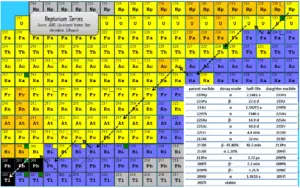 The neptunium series is a radioactive series beginning with neptunium-237. Its members are produced artificially by nuclear reactions and do not occur naturally, because the half-life of the longest lived isotope in the series is short compared to the age of the earth. This radioactive decay chain consists of unstable heavy atomic nuclei that decay through a sequence of alpha and beta decays until a stable nucleus is achieved. In case of neptunium series, the stable nucleus is bismuth-209 (with half-life of 1.9E19 years) and thallium-205.
The neptunium series is a radioactive series beginning with neptunium-237. Its members are produced artificially by nuclear reactions and do not occur naturally, because the half-life of the longest lived isotope in the series is short compared to the age of the earth. This radioactive decay chain consists of unstable heavy atomic nuclei that decay through a sequence of alpha and beta decays until a stable nucleus is achieved. In case of neptunium series, the stable nucleus is bismuth-209 (with half-life of 1.9E19 years) and thallium-205.
Since alpha decay represents the disintegration of a parent nucleus to a daughter through the emission of the nucleus of a helium atom (which contains four nucleons), there are only four decay series. Within each series, therefore, the mass number of the members may be expressed as four times an appropriate integer (n) plus the constant for that series. As a result, the neptunium series is known as the 4n+1 series.
The total energy released from neptunium-237 to thallium-205, including the energy lost to neutrinos, is 50.0 MeV.
In some kind of smoke detectors, you can meet radionuclides from this series. Ionization smoke detectors usually use a radioisotope, typically americium-241, to ionize air and to detect smoke. In this case americium-241 decays to neptunium-237 and is, in fact, a member of neptunium series.
Types of Decay in Neptunium Series
Within each radioactive series, there are two main modes of radioactive decay:
- Alpha decay. Alpha decay represents the disintegration of a parent nucleus to a daughter through the emission of the nucleus of a helium atom. Alpha particles consist of two protons and two neutrons bound together into a particle identical to a helium nucleus. Because of its very large mass (more than 7000 times the mass of the beta particle) and its charge, it heavy ionizes material and has a very short range.
- Beta decay. Beta decay or β decay represents the disintegration of a parent nucleus to a daughter through the emission of the beta particle. Beta particles are high-energy, high-speed electrons or positrons emitted by certain types of radioactive nuclei such as potassium-40. The beta particles have greater range of penetration than alpha particles, but still much less than gamma rays.The beta particles emitted are a form of ionizing radiation also known as beta rays. The production of beta particles is termed beta decay.
We hope, this article, Neptunium Series, helps you. If so, give us a like in the sidebar. Main purpose of this website is to help the public to learn some interesting and important information about radiation and dosimeters.